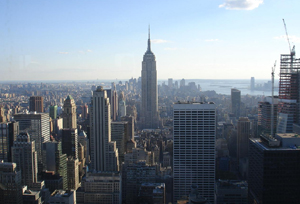 "What does the world need most that we are uniquely able to provide?" That’s the question Jeffrey Hollender, Seventh Generation co-founder and chief inspired protagonist, poses on the company Web page heralding the release of its 2008 Corporate Conscious Report.
"What does the world need most that we are uniquely able to provide?" That’s the question Jeffrey Hollender, Seventh Generation co-founder and chief inspired protagonist, poses on the company Web page heralding the release of its 2008 Corporate Conscious Report. Seventh Generation, which makes environmentally friendly and natural household and personal care products, is a progressive and growing company. For a company that has long been looking ahead and measuring its success against the greater good, Hollender wonders about the future corporate social responsibility and its far-reaching impact on businesses.
…a growing breed of good companies has heard President Obama's call to a “new era of responsibility." Fueled by an emerging generation of business leaders, these companies are committed to merging economic growth with social justice. They view the financial crisis and the climate crisis as once-in-a-lifetime opportunities to unleash principled behavior for the greater good. For them, values and principles are sources of innovation—opportunities to create products and services that deliver a Return on Purpose as well as a Return on Investment.
And, so, we return to Hollender’s initial question about what the world needs that our business can uniquely provide. Thought-provoking discussion topics, no doubt.
This is a great time to step back and take a look at your own business and its impact on your local community, your state, your region and ultimately the world. For many companies, it means taking an initial step toward more recycling or reducing energy consumption in the office. For others, it could mean going further in its effort by selecting like-minded suppliers and vendors.
In this “new era responsibility,” more individuals are taking a stand for the environment and that means businesses have to get on board. It explains why a company like Seventh Generation is growing – its products and its corporate mission strike a cord with many consumers. Can the same be said for your business?
If your company had to put together a corporate responsibility report, what would it say? Post a comment and let us know how your office is making a difference.
For inspiration, check out the online book Seventh Generation is working on that highlights best practices in corporate social responsibility. The company has partnered up with Justmeans, an online network for responsible business, to explore how the growing breed of socially responsible companies can become a voice in shifting business as we know it. Stop by the Web site to submit your ideas to the book or to simply be inspired.
[ add comment ] ( 71 views ) | [ 0 trackbacks ] | permalink |




 ( 3 / 2535 )
( 3 / 2535 )  The stores are filled with crayons, markers, glue sticks and Hannah Montana notebooks. It’s back-to-school time. OK, so you’re not going back to school, you’re just headed back to the office for another wild work week. But you can turn this back-to-school time into an opportunity to introduce some green into the workplace.
The stores are filled with crayons, markers, glue sticks and Hannah Montana notebooks. It’s back-to-school time. OK, so you’re not going back to school, you’re just headed back to the office for another wild work week. But you can turn this back-to-school time into an opportunity to introduce some green into the workplace. Seems this time of the year is perfect for offices to take stock of their supply cabinets and look for ways to reduce consumption or switch at least a few items to more environmentally options.
• Paper clips made from recycled steel.
• Pencils made from blue jeans and newspaper.
• This looks neat: a staple-free stapler, which makes it easier to drop your paper in the recycling bin or use the blank sides of that 30-page report for printing without having to pick out the staples. Check it out here.
• Check out TerraCycle Inc. for a host of nifty office supplies made from recycled products. They have pouch pencil cases, folders and lunch boxes made from old juice boxes. And you’re sure to be the talk of the boardroom with a notebook made from an old Double Stuff Oreo wrapper.
These days it’s fairly easy to find recycled paper, notepads and Post-it Notes made of 30 percent postconsumer content (or more). In fact, just about all stores carry some environmentally friendly office supplies, and larger stores have devoted entire product lines to earth-friendly items, such as Staples EcoEasy and Office Deport Green.
But you carry this school concept beyond the office supplies. Try turning the next few weeks into a time to educate your co-workers, management and customers with a “back to school – green style” theme.
A couple of ideas to get you started:
• Pack your lunch. For one week, encourage all employees to bring their lunch. The catch is the lunches have to be sustainable – put food in reusable containers, bring a cloth napkin and pack some locally grown fruits or veggies.
• No printing week. Employees are allowed to print two sheets of paper a day, which gets them thinking about whether a document really needs printed.
• Community service grade. Invite a guest speaker or two from local environment groups to talk about their organizations and how employees can get involved, either individually as a company.
It’s a great chance to educate your co-workers about being more environmentally conscious and in a fun way. And, the best part: no final exams.
Ideas for how to educate your co-workers on going green? Post a comment and share your ideas.
[ 4 comments ] ( 1556 views ) | [ 0 trackbacks ] | permalink |




 ( 3.1 / 55 )
( 3.1 / 55 ) 
Mary Lou LoPreste’s goal is simple: to ensure the water, the mountains and the earth she has always enjoyed will be around for her children and grandchildren.
LoPreste is probably most well known for her work on Sun Harbor Marina, a property she previously owned and managed in the San Diego Harbor. The marina complex was the first marina to receive Leadership in Energy and Environmental Design certification.
When she first mentioned the idea of renovating the marina into a sustainable property, no one knew what she was talking about, LoPreste said.
The marina project, which was completed in early 2005 and was awarded LEED certification from the U.S. Green Building Council the following year, was truly ahead of its time. LoPreste said they recycled about 90 percent of the buildings that were taken down. The marina – which relies heavily on natural lighting – saves more than 35 percent on water and electricity.
Other green features included interior lights that automatically shut off after 9 p.m. and a smart energy system that will turn off the air conditioning if a window is open.
The stone used in the development was mined within 1,200 miles of San Diego. LoPreste opted to use recycled lumber and renewable building materials. At the time, using those types of materials cost LoPreste about 5 percent more than it would cost today because now they are more readily available.
“I believe we have to have renewable lumber,” she said. “Cutting trees is completely stupid and irresponsible and so disruptive.”
LoPreste no longer owns Sun Harbor Marina, but she still is spreading the green message around the country, working as a green building consultant, particularly encouraging marina owners to color their facilities green.
LoPreste is truly passionate about green building and urges businesses to look at how important it is to consider the aspects of building green. And yet her message extends to all businesses and individuals as she makes a case for the simple changes that have a big impact: recycling, switching to energy-efficient light bulbs or turning off the water when brushing your teeth.
“You have to open your eyes a little bit wider and see what the impact of billions of people can be,” she said. “Its’ awareness, awareness, awareness. We are in a global warming stage and people really need to wake up to that.”
As for her three grown children and four grandchildren, the activism runs in the family. Even her grandchildren conserve water or pick up trash when they are out taking a walk. “They are very aware of what’s happening,” she said. “You have to be the pebble that’s thrown in the water.”
LoPreste will share her message with anyone who will listen to the issues facing the global environment.
“I’d really like to give a sharp wakeup call to people and encourage people to stop thinking this is a transient thing, this devastation and global warming,” she said. “Just do one or two things that will make a difference. Start spreading the word. I don’t want to be an alarmist, but we all need to wake up and think about what we’ve experienced in our lives and ensure future generations have the same resources we’ve enjoyed.”
For more about Mary Lou LoPreste, visit her Web site.
(Photo courtesy/lopreste.com)
[ add comment ] ( 112 views ) | [ 0 trackbacks ] | permalink |




 ( 3 / 2510 )
( 3 / 2510 )  It’s one thing for a business to commit to implementing green office practices like recycling, installing light fixtures that turn off when no one is in the room or installing a bike rack for employees who don’t want to drive to the office. But it takes an even larger commitment to turn the entire physical office building green.
It’s one thing for a business to commit to implementing green office practices like recycling, installing light fixtures that turn off when no one is in the room or installing a bike rack for employees who don’t want to drive to the office. But it takes an even larger commitment to turn the entire physical office building green. Major commercial real estate company CB Richard Ellis has enrolled 225 office buildings in the U.S. Green Building Council’s Leadership in Energy and Environmental Design – Existing Building (LEED EB) program. According to a news release, at the end of 2007, CBRE committed to enroll a minimum 100 buildings in the then-emerging LEED EB process. Now, the company is the largest third-party manager of buildings in this program for environmental sustainability.
The properties CBRE enrolled in the LEED EB program total more than 57 million square feet and are owned by more than 55 different investors and corporations in 21 states. That’s a pretty big green footprint.
“When we made our commitment in 2007 there were fewer than 60 buildings in the entire country with LEED EB designation,” said David Pogue, CBRE’s national director of sustainability. “The key to our success has been building a strong foundation, by both partnering effectively with our clients and deploying a strong internal certification team with great technical expertise and a genuine passion for enhancing sustainable practices in the buildings we manage.”
CBRE currently manages 17 buildings that have attained LEED EB certification; that total is expected to grow to 50 buildings by the end of 2009. A Green Thumbs Up to CB Richard Ellis.
Earlier this month, the San Diego County Regional Airport Authority broke ground on its Green Build, formerly known as the Terminal Development Program, which will be the most extensive improvements ever carried out at San Diego International, according to Aviation News.
The project includes the construction of 10 new jet gates, a dual-level roadway at Terminal 2 to separate arriving and departing passengers and new dining and shopping options. Airport officials plan to incorporate sustainable design principles into the project with a larger goal of achieving LEED silver certification.
Even as high profile buildings like the Empire State Building and the Sears Tower take strides toward being more efficient, the need continues for buildings to take a look at how they can be more environmentally friendly. And in this current economic climate, it just makes sense to gain a competitive edge.
Here’s a great piece from Mother Nature Network about the need for commercial buildings to go green.
As blogger Melissa Hincha-Ownby writes,
As more companies begin to commit to sustainability, the demand for green office space will only rise. Depending on the size of the project, green building retrofits can take years to complete so wise building owners are getting started on these renovations sooner vs. later.
Do you have examples of commercial buildings that are going green? Let us know! We’re always looking for companies to profile on their journey to sustainability.
[ 2 comments ] ( 103 views ) | [ 0 trackbacks ] | permalink |




 ( 3 / 3004 )
( 3 / 3004 ) 
This post is devoted to some great green ideas I’ve come across recently, some of which can be useful to your office or home and others that provide some inspiration for just how easy it can be to go green if you just put your mind to it and get creative.
Granted the use of e-mail, various online file sharing services and electronic faxes have eliminated a great deal of the mail we receive, but junk mail is another story. It seems there are many days when the mailbox runneth over with catalogs and credit card offers.
Check out these stats from 41pounds.org, a nonprofit organization working to eliminate junk mail:
• The average adult receives 41 pounds of junk mail each year; 44% goes to the landfill unopened.
• On average, we receive 16 pieces of junk mail a week, compared to only 1.5 personal letters.
• The majority of household waste consists of junk mail.
• Junk mail inks have high concentrations of heavy metals, making the paper difficult to recycle.
• California’s state and local governments spend $500,000 a year collecting and disposing of AOL’s direct mail disks alone.
• Transporting junk mail costs $550 million a year.
Yikes! That’s a lot of junk mail. So, what can you do? Sites like 41pounds.org and YellowPagesGoesGreen.org will contact distributors on your behalf and stop the unwanted mail. 41pounds.org does charge a fee ($41 for a five-year period and does donate a portion of each new subscriber’s fee to an environmental charity of their choice).
And while you’re at it, check out Junk Mail Gems, which makes useful items from, you guessed it, junk mail. Everyone has some scratch paper next to the office phone, so why not store it in a box made from junk mail? Green Thumbs Up, Junk Mail Gems!
The city of Charleston, S.C., is assessing ways to reduce energy consumption in the city, not only making the city greener, but also creating green jobs. The city’s Boston-based consultant Serrafix recommends the city launch an organization that would give businesses and homeowners everything they need to know about energy-efficiency projects in one place.
According to this article in The Post & Courier: “From this single organization a building owner could arrange a home energy audit, find out what changes would produce the greatest savings, learn about rebates and government incentives, select an approved contractor, and have the work done with no up-front cost. The building owner would realize utility bill savings immediately, and pay off improvement costs over an extended period of time through a surcharge on their water bill.”
Charleston could become a national model for energy efficiency if it implements some of the recommended programs.
You know those entertainment books filled with retail and restaurants coupons? Well, San Diego now has something similar but with a green twist. The “Go Green Book” ($25) has coupons from eco-friendly retailers as well as tips and ideas for how to green your home, dine on organic food, get fit and exploring San Diego’s many parks and attractions. What a great way to save some green! (Employers, think about this as a good employee incentive gift.)
OK, let’s hear the cool green ideas you’ve found recently. Post a comment below.
[ add comment ] ( 56 views ) | [ 0 trackbacks ] | permalink |




 ( 3 / 2572 )
( 3 / 2572 ) 


 Looking for a Green Office Solution?
Looking for a Green Office Solution?